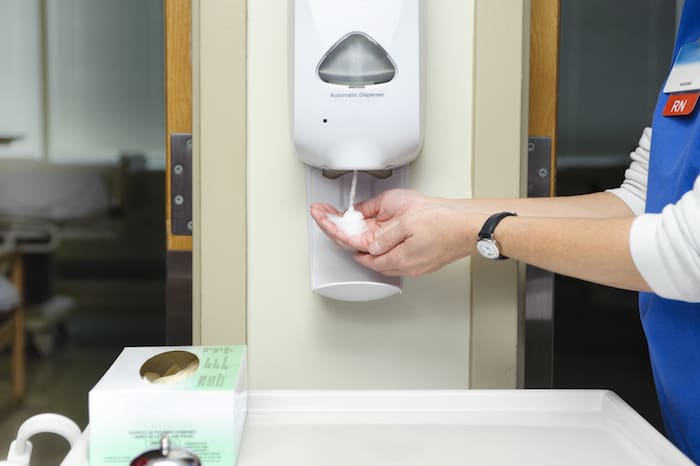By Sean Gallimore
In today’s modern, high-tech hospitals and healthcare facilities, there are hand-sanitizer stations around every corner, gloves on nearly every hand, and standardized, top-to-bottom cleaning procedures. Healthcare professionals are using wipes, sprays, detergents and other cleaning products. Equipment, rooms and surgical procedures are undergoing strict cleaning and sterilization protocols. Yet, each year, there are an estimated 687,000 hospital-associated infections (HAIs), resulting in associated 72,000 deaths and costing an estimated $11 million annually, according to the Center for Disease Control (CDC).
Although there has been significant progress with new innovations and products in infection prevention, more needs to be done. Today, healthcare care environments need to embrace a more integrated, holistic approach.
HAIs are pervasive
With the constant influx and turnover of patients and a multitude of infectious agents common in healthcare facilities, HAIs are, without a doubt, challenging and costly. They are both difficult to prevent due to their persistent, communicable nature — and tough to treat given the rise of drug-resistant microorganisms. HAIs have many sources — they can be transmitted through surfaces (including floors, counters and linens), hands of the healthcare worker, a patient’s own skin, catheters and equipment.
Furthermore, growing evidence indicates that the environment contributes to disease transmission and infections. The prevalence and complexities of HAIs require facilities to focus on fostering a cleaner environment overall. Adopting a comprehensive, layered approach, which includes the combination of traditional hard-surface disinfection with total room terminal disinfection, is key.
What does an integrated approach encompass?
A holistic line of attack to reducing HAIs should incorporate protocols and procedures that address all potential sources of transmission and contamination, including the three main vectors and the overall environment.
- Hands: Consistent handwashing and use of gloves among healthcare workers are a must.
- Patient’s skin: Using disposable wipes, antiseptics and cleansing agents for a patient’s skin hygiene, strict surgical protocols, and equipment sterilization will help protect patients.
- Surface/environment: Daily discharge cleaning and disinfecting for room surfaces, including total room disinfection is critical.
Automated technologies
Traditional manual cleaning and disinfection practices in hospitals remain highly essential. However, these methods are not always sufficient. In fact, according to studies, less than 50 percent of hospital room surfaces are adequately cleaned and disinfected, due to porous and difficult to reach surfaces, as well as non-compliance to cleaning protocols. This has led to a greater use of new technologies that provide total room disinfection.
“No-touch” (automated) decontamination technologies include ultraviolet (UV-C) light, vaporized hydrogen peroxide or mist (VHP or HPM), other light disinfection, and self-disinfecting surfaces. According to the National Institutes of Health, several studies have shown that these technologies are effective in reducing bacterial contamination of surfaces. VHP/HPM works by quickly increasing the concentration of hydrogen peroxide in the room for decontamination using a portable generator, which is repeated several times. The UV-C systems emit UV light from portable automated units at a wave-length that kills bacteria, viruses and other pathogens. These methods provide reliable, safe and rapid decontamination against a wide range of infectious agents according to clinical studies.
Combining touch and no-touch is critical
It is important to note that “no touch” methods should not replace surface cleaning and disinfection, but rather be used in conjunction with more traditional “touch” cleaning protocols, especially when patients are being treated and bioburden may be present. A recent CDC-funded study by Duke University showed that UV-C technology in combination with compliant manual disinfection that included the use of surface disinfectant wipes, reduced the relative risk of colonization and infection by a cumulative 30% among patients in hospital settings. While effective and efficient in hard-to-reach areas, UV light does not eradicate dust, debris, and other surface material. Traditional manual cleaning and disinfection are still required to achieve an ideal pathogen-free environment.
Education and training
A successful integrated approach to infection prevention must include education, training, and clinical support throughout the organization. For best practices, healthcare facilities need to establish a comprehensive, layered set of procedures combining appropriate cleaning and disinfecting products and “no touch” technology, educate staff on proper protocols, and monitor compliance, as noted in a recent American Journal of Infection Control report. As innovations continue to revolutionize the industry, we will be better armed to tackle preventable infections, while reducing costs, and ultimately saving lives.
Sean Gallimore currently serves as Senior Vice President and General Manager for PDI Healthcare, where he has overall strategic and financial responsibility for the healthcare division.
Supporting References
https://www.cdc.gov/hai/index.html
https://www.ncbi.nlm.nih.gov/pmc/articles/PMC4827199/
https://www.ncbi.nlm.nih.gov/pubmed/27131140
https://www.ncbi.nlm.nih.gov/pmc/articles/PMC4920602/
https://www.ncbi.nlm.nih.gov/pubmed/25577931
https://www.ncbi.nlm.nih.gov/pubmed/31146858
https://www.cleanlink.com/cleanlinkminute/details/Dont-Undervalue-UV-Cleaning–58641
The Editorial Team at Healthcare Business Today is made up of skilled healthcare writers and experts, led by our managing editor, Daniel Casciato, who has over 25 years of experience in healthcare writing. Since 1998, we have produced compelling and informative content for numerous publications, establishing ourselves as a trusted resource for health and wellness information. We offer readers access to fresh health, medicine, science, and technology developments and the latest in patient news, emphasizing how these developments affect our lives.









1 thought on “An Integrated Approach is Key for Successful Hospital Infection Prevention”
Comments are closed.